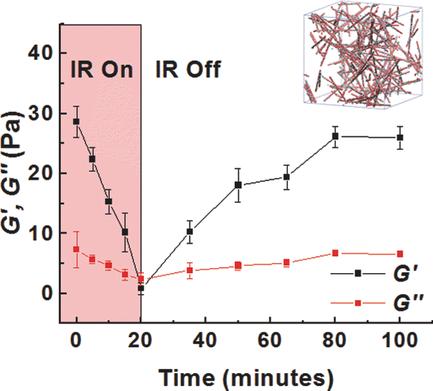当前位置:
X-MOL 学术
›
Macromol. Rapid Commun.
›
论文详情
Our official English website, www.x-mol.net, welcomes your feedback! (Note: you will need to create a separate account there.)
Optothermally Reversible Carbon Nanotube–DNA Supramolecular Hybrid Hydrogels
Macromolecular Rapid Communications ( IF 4.6 ) Pub Date : 2017-10-24 , DOI: 10.1002/marc.201700587 Nikhita D. Mansukhani 1 , Linda M. Guiney 1 , Zonghui Wei 2 , Eric W. Roth 1 , Karl W. Putz 1 , Erik Luijten 1, 2, 3, 4 , Mark C. Hersam 1, 2, 5, 6
Macromolecular Rapid Communications ( IF 4.6 ) Pub Date : 2017-10-24 , DOI: 10.1002/marc.201700587 Nikhita D. Mansukhani 1 , Linda M. Guiney 1 , Zonghui Wei 2 , Eric W. Roth 1 , Karl W. Putz 1 , Erik Luijten 1, 2, 3, 4 , Mark C. Hersam 1, 2, 5, 6
Affiliation

|
Supramolecular hydrogels (SMHs) are three‐dimensional constructs wherein the majority of the volume is occupied by water. Since the bonding forces between the components of SMHs are noncovalent, SMH properties are often tunable, stimuli‐responsive, and reversible, which enables applications including triggered drug release, sensing, and tissue engineering. Meanwhile, single‐walled carbon nanotubes (SWCNTs) possess superlative electrical and thermal conductivities, high mechanical strength, and strong optical absorption at near‐infrared wavelengths that have the potential to add unique functionality to SMHs. However, SWCNT‐based SMHs have thus far not realized the potential of the optical properties of SWCNTs to enable reversible response to near‐infrared irradiation. Here, we present a novel SMH architecture comprised solely of DNA and SWCNTs, wherein noncovalent interactions provide structural integrity without compromising the intrinsic properties of SWCNTs. The mechanical properties of these SMHs are readily tuned by varying the relative concentrations of DNA and SWCNTs, which varies the cross‐linking density as shown by molecular dynamics simulations. Moreover, the SMH gelation transition is fully reversible and can be triggered by a change in temperature or near‐infrared irradiation. This work explores a new regime for SMHs with potential utility for a range of applications including sensors, actuators, responsive substrates, and 3D printing.
中文翻译:

光热可逆碳纳米管-DNA超分子杂化水凝胶
超分子水凝胶(SMHs)是三维结构,其中大部分体积被水占据。由于SMH组件之间的键合力是非共价的,因此SMH属性通常是可调的,刺激响应的和可逆的,这使应用程序可以触发药物释放,传感和组织工程。同时,单壁碳纳米管(SWCNT)具有最强的导电性和导热性,较高的机械强度以及在近红外波长处的强光吸收能力,有可能为SMH添加独特的功能。但是,迄今为止,基于SWCNT的SMH尚未意识到SWCNT的光学特性具有潜在的可逆响应近红外辐射的潜力。在这里,我们提出了一种新颖的SMH架构,该架构仅包含DNA和SWCNT,其中非共价相互作用提供结构完整性而不损害SWCNT的固有性质。通过改变DNA和SWCNT的相对浓度,可以改变这些SMH的机械性能,如分子动力学模拟所示,这会改变交联密度。此外,SMH凝胶化转变是完全可逆的,并且可以由温度变化或近红外辐射触发。这项工作探索了一种SMH的新机制,该新机制在包括传感器,致动器,响应性基材和3D打印在内的一系列应用中具有潜在的实用性。如分子动力学模拟所示,它改变了交联密度。此外,SMH凝胶化转变是完全可逆的,并且可以由温度变化或近红外辐射触发。这项工作探索了一种SMH的新机制,该新机制在包括传感器,致动器,响应性基材和3D打印在内的一系列应用中具有潜在的实用性。如分子动力学模拟所示,它改变了交联密度。此外,SMH凝胶化转变是完全可逆的,并且可以由温度变化或近红外辐射触发。这项工作探索了一种SMH的新机制,该新机制在包括传感器,致动器,响应性基材和3D打印在内的一系列应用中具有潜在的实用性。
更新日期:2017-10-24
中文翻译:

光热可逆碳纳米管-DNA超分子杂化水凝胶
超分子水凝胶(SMHs)是三维结构,其中大部分体积被水占据。由于SMH组件之间的键合力是非共价的,因此SMH属性通常是可调的,刺激响应的和可逆的,这使应用程序可以触发药物释放,传感和组织工程。同时,单壁碳纳米管(SWCNT)具有最强的导电性和导热性,较高的机械强度以及在近红外波长处的强光吸收能力,有可能为SMH添加独特的功能。但是,迄今为止,基于SWCNT的SMH尚未意识到SWCNT的光学特性具有潜在的可逆响应近红外辐射的潜力。在这里,我们提出了一种新颖的SMH架构,该架构仅包含DNA和SWCNT,其中非共价相互作用提供结构完整性而不损害SWCNT的固有性质。通过改变DNA和SWCNT的相对浓度,可以改变这些SMH的机械性能,如分子动力学模拟所示,这会改变交联密度。此外,SMH凝胶化转变是完全可逆的,并且可以由温度变化或近红外辐射触发。这项工作探索了一种SMH的新机制,该新机制在包括传感器,致动器,响应性基材和3D打印在内的一系列应用中具有潜在的实用性。如分子动力学模拟所示,它改变了交联密度。此外,SMH凝胶化转变是完全可逆的,并且可以由温度变化或近红外辐射触发。这项工作探索了一种SMH的新机制,该新机制在包括传感器,致动器,响应性基材和3D打印在内的一系列应用中具有潜在的实用性。如分子动力学模拟所示,它改变了交联密度。此外,SMH凝胶化转变是完全可逆的,并且可以由温度变化或近红外辐射触发。这项工作探索了一种SMH的新机制,该新机制在包括传感器,致动器,响应性基材和3D打印在内的一系列应用中具有潜在的实用性。


























 京公网安备 11010802027423号
京公网安备 11010802027423号